Epidemiology of adult rib fracture and factors associated with surgical fixation: analysis of a chest wall injury dataset from England and Wales
ABSTRACT NUMBER: NESS_9
AUTHORS
Helen MA Ingoe, William Eardley, Catriona McDaid, Amar Rangan, Catherine Hewitt
MAIN ABSTRACT TEXT
Surgical fixation of rib fractures (SFRF) is growing in popularity as part of optimising care of patients with rib fractures. There is currently no description of the epidemiology of these injuries at a national level; nor has there been identification of factors that predict which of these patients undergo surgery.
The Trauma Audit Research Network (TARN) database was analysed for the period April 2016 to 30th May 2017 for all adult patients presenting with a rib or sternal fracture. Characteristics of the population were described and a binary logistic regression model constructed to explore the influences of explanatory variables on whether SFRF was performed.
Of 16,638 patients with chest wall trauma, 402 underwent SFRF. Most rib fracture patients were admitted under three specialties (orthopaedics (19.1%), emergency medicine (16.6%) and general surgery (17.7%)). The odds of SFRF in unilateral flail chest was 107.51 (p <0.0001), in bilateral flail or combined complex sternal fracture 47.63 (p=0.007) and in 3 or more non-flail ribs 15.62 (p<0.0001) when compared to less than three non-flail rib fractures. The odds of SFRF was higher in an MTC (p<0.0001) compared to a non-specialist hospital. The odds of SFRF was higher in older patients (1.02, p<0.0001) and the more severely injured (1.02, p<0.0001).
Injury type, patient age and care setting contribute to decision making in SFRF. This unique national dataset characterises for the first time the nature of contemporary chest wall trauma management and should help inform the design of future research on this topic.
